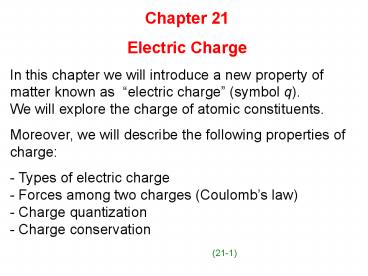Electric Charge - PowerPoint PPT Presentation
1 / 15
Title: Electric Charge
1
Chapter 21 Electric Charge In this chapter we
will introduce a new property of matter known as
electric charge (symbol q).
We will
explore the charge of atomic constituents.
Moreover, we will
describe the following properties of charge -
Types of electric charge
- Forces among two charges (Coulombs
law)
- Charge quantization
- Charge
conservation
(21-1)
2
Empirically it was known since ancient times that
if amber is rubbed on cloth, it acquires the
property of attracting light objects such as
feathers. This phenomenon was attributed to a
new property of matter called electric charge.
(Electron is the Greek name for amber.) More
experiments show that there are two distinct
types of electric charge positive (color code
red) and negative (color code black). The names
positive and negative were given by Benjamin
Franklin.
When we rub a glass rod with silk cloth,
both objects acquire electric charge. The sign on
the charge on the glass rod is defined as
positive.
In a similar fashion, when we rub a plastic
rod with fur both objects acquire electric
charge. The sign on the charge on the plastic rod
is defined as negative. (21-2)
3
- Q Do we have enough information so as to be
able to determine the sign of all other charges
in nature? To answer this question we need one
more piece of information. - Further experiments on charged objects showed
that - Charges of the same type (either both positive or
both negative) repel each other (fig. a).
- Charges of opposite type on the other hand
attract each other (fig. b).
The force
direction allows us to determine the sign of an
unknown electric charge.
Charges of the same sign repel each other.
Charges of opposite sign attract each other.
(21-3)
4
The recipe is as follows We charge a glass
rod by rubbing it with silk cloth. Thus we know
that the charge on the glass rod is positive.
The rod is suspended in such a way so that it can
keep its charge and also rotate freely under the
influence of a force applied by charge with the
unknown sign. We approach the suspended class
rod with the new charge whose sign we wish to
determine.
Two outcomes are possible. These are shown in the
figure to the left
Fig. a The two objects
repel each other. We then conclude that the
unknown charge has a positive sign. Fig. b The
two objects attract each other. We then conclude
that the unknown charge has a negative sign.
(21-4)
5
In Benjamin Franklins day (18th century) it was
assumed that electric charge is some type of
weightless continuous fluid. Investigations of
the structure of atoms by Ernest Rutherford at
the beginning of the 20th century revealed how
matter is organized and also identified that
charge of its constituents. Atoms consist of
electrons and the nucleus.
Atoms have sizes ? 5?10-10
m. Nuclei have sizes ? 5?10-15 m.
The nucleus itself consists of two types
of particles protons and neutrons.
The electrons are
negatively charged. The protons are positively
charged. The neutrons are neutral (zero charge).
Thus electric charge is a fundamental property of
the elementary particles (electrons, protons,
neutrons) out of which atoms are made.
(21-5)
6
Mass and Charge of Atomic Constituents Neutron
(n) Mass m 1.675?10-27 kg Charge q
0 Proton (p) Mass m 1.673?10-27 kg
Charge q 1.602?10-19 C Electron (e) Mass
m 9.11?10-31 kg Charge q -1.602?10-19
C Note 1 We use the symbols -e and e for
the electron and proton charge, respectively.
This is known as the elementary charge.
Note
2 Atoms are electrically neutral. The number
of electrons is equal to the number of protons.
This number is known as the atomic number
(symbol Z). The chemical properties of atoms are
determined exclusively by Z. Note
3 The sum of the number of protons and the
number of neutrons is known as the mass number
(symbol A). Notation
Z 92 number of protons/electrons
A 235
number of protons neutrons The atomic number Z
92 defines the nucleus as that of a uranium
atom.
(21-6)
7
(21-7)
8
Conservation of Charge Consider a glass rod and a
piece of silk cloth (both uncharged) shown in the
upper figure. If we rub the glass rod with the
silk cloth we know that positive charge appears
on the rod (see lower figure). At the same time
an equal amount of negative charge appears on the
silk cloth, so that the net rod-cloth charge is
actually zero. This suggests that rubbing does
not create charge but only transfers it from one
body to the other, thus upsetting the electrical
neutrality of each body. Charge conservation can
be summarized as follows In any process the
charge at the beginning equals the charge at the
end of the process.
(21-8)
9
(21-9)
10
(21-10)
11
(21-11)
12
(21-12)
13
(21-13)
14
(21-14)
15
(21-15)

